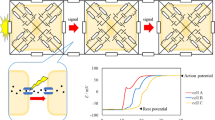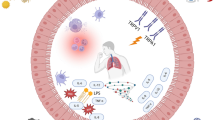Abstract.
There are two contradictory explanations for central respiratory rhythmogenesis. One suggests that respiratory rhythm emerges from interaction between inspiratory and expiratory neural semicenters that inhibit each other and thereby provide reciprocal rhythmic activity (Brown 1914). The other uses bursting pacemaker activity of individual neurons to produce the rhythm (Feldman and Cleland 1982). Hybrid models have been developed to reconcile these two seemingly conflicting mechanisms (Smith et al. 2000; Rybak et al. 2001). Here we report computer simulations that demonstrate a unified mechanism of the two types of oscillator. In the model, we use the interaction of Ca++-dependent K+ channels (Mifflin et al. 1985) with Ca++-induced Ca++ release from intracellular stores (McPherson and Campbell 1993), which was recently revealed in neurons (Hernandez-Cruz et al. 1997; Mitra and Slaughter 2002a,b; Scornik et al. 2001). Our computations demonstrate that uncoupled neurons with these intracellular mechanisms show conditional pacemaker properties (Butera et al. 1999) when exposed to steady excitatory inputs. Adding weak inhibitory synapses (based on increased K+ conductivity) between two model neural pools surprisingly synchronizes the activity of both neural pools. As inhibitory synaptic connections between the two pools increase from zero to higher values, the model produces first dissociated pacemaker activity of individual neurons, then periodic synchronous bursts of all neurons (inspiratory and expiratory), and finally reciprocal rhythmic activity of the neural pools.
Similar content being viewed by others
Acknowledgments.
This work was supported by the TTU HSC School of Medicine seed grant for the year 2001 and NIH grant NS46062. We thank Drs. S. Gyorke and S. Viatchenko-Karpinski for discussion of CICR functional properties.
Author information
Authors and Affiliations
Corresponding author
Rights and permissions
About this article
Cite this article
Dunin-Barkowski, W., Escobar, A., Lovering, A. et al. Respiratory pattern generator model using Ca++-induced Ca++ release in neurons shows both pacemaker and reciprocal network properties. Biol. Cybern. 89, 274–288 (2003). https://doi.org/10.1007/s00422-003-0418-6
Received:
Accepted:
Published:
Issue Date:
DOI: https://doi.org/10.1007/s00422-003-0418-6




